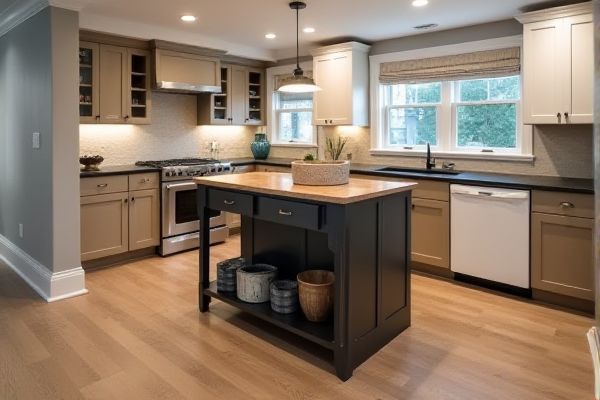
A rolling cart offers flexibility and mobility, allowing you to easily move storage or work surfaces around your basement to suit changing needs, while a stationary island provides a stable, permanent feature for organizing tools or crafting space. Discover which option best fits your basement setup by exploring the detailed comparison in the article below.
Table of Comparison
| Feature | Rolling Cart | Stationary Island Basement |
|---|---|---|
| Mobility | Highly mobile, easily moved around | Fixed, immobile installation |
| Space Usage | Compact, flexible for small spaces | Requires dedicated space, larger footprint |
| Storage Capacity | Limited shelves and compartments | Extensive built-in storage options |
| Installation | No installation needed, plug and play | Requires professional installation |
| Cost | Generally affordable | Higher investment expense |
| Durability | Moderate, depends on material quality | High, built to last with solid construction |
| Use Case | Temporary or multi-purpose use | Permanent kitchen or basement setup |
Introduction to Rolling Carts and Stationary Islands
Rolling carts offer versatile storage and mobility in basement spaces, allowing easy reconfiguration and access to tools or supplies. Stationary islands provide a fixed, sturdy workspace with ample surface area and built-in storage, ideal for organized projects and heavy-duty tasks. Both options enhance basement functionality but cater to different needs based on space flexibility and usage intensity.
Space Efficiency: Mobility vs. Permanence
Rolling carts offer versatile mobility, allowing you to maximize space efficiency in a basement by easily relocating storage or work surfaces as needed. Stationary islands provide permanent, sturdy configurations that optimize a fixed area but lack the flexibility for rearrangement. Choosing between them depends on whether your priority is adaptable space management or a stable, dedicated workspace.
Design Flexibility and Customization Options
Rolling carts offer unmatched design flexibility, allowing you to easily reposition storage and work surfaces throughout your basement as needs change. Stationary islands provide customization opportunities through built-in cabinetry, countertops, and fixtures tailored to your specific space and style preferences. Your choice depends on whether mobility or a fixed, personalized centerpiece best suits your basement layout and functionality requirements.
Storage Capacity Comparison
A stationary island in your basement typically offers greater storage capacity than a rolling cart due to its fixed, larger footprint and built-in cabinets or drawers. Rolling carts provide flexible storage but are limited by compact dimensions and fewer compartments. Choose a stationary island for maximizing storage space and a rolling cart for mobility and smaller-scale organization.
Installation and Setup Requirements
Rolling carts require minimal installation, typically only assembly of parts with basic tools, making them highly portable and easy to reposition within basement spaces. Stationary kitchen islands demand substantial installation, including leveling, securing to the floor, and sometimes plumbing or electrical hookups for added features, resulting in a more permanent fixture. The choice between a rolling cart and a stationary island hinges on the user's preference for flexibility versus stability and the complexity of setup they are willing to undertake.
Functionality and Multipurpose Use
Rolling carts offer superior functionality and multipurpose use in basements by providing mobility, allowing users to easily relocate tools, supplies, or entertainment accessories as needed. In contrast, stationary islands serve as fixed, stable workstations or storage units, ideal for consistent use in a designated area. The adaptability of rolling carts supports dynamic activities, while stationary islands excel in organized, stationary setups.
Cost Analysis and Budget Considerations
Rolling carts generally cost less upfront, with prices ranging from $50 to $300 depending on materials and size, making them budget-friendly for temporary or flexible basement setups. Stationary basement islands typically require higher investment, often between $500 and $3,000, due to custom cabinetry, materials, and installation fees, impacting overall renovation budgets significantly. Long-term value considerations include durability and functionality, where stationary islands may increase home value but require a larger initial capital outlay compared to cost-effective rolling carts.
Durability and Maintenance Factors
Rolling carts offer flexibility with lightweight construction, often featuring materials like steel or plastic that resist rust and require minimal upkeep. Stationary basement islands typically use sturdy wood or metal frames with durable countertops such as granite or quartz, offering long-lasting stability but demanding occasional maintenance like sealing or polishing. Choosing between the two depends on balancing the need for mobility against preferences for robust, low-maintenance durability in a basement setting.
Basement Aesthetic and Design Integration
A rolling cart offers flexible storage and can be moved to suit different basement layouts, enhancing versatile design integration without permanent alteration. A stationary island creates a fixed focal point that anchors the basement's aesthetic, providing a cohesive and stable design element. Your choice will impact how easily you can adapt the space's functionality and overall visual harmony.
Choosing the Right Solution for Your Basement Needs
A rolling cart offers flexible storage and mobility, ideal for basements requiring frequent reorganization or multi-purpose use. Stationary islands provide a sturdy, permanent workspace with ample surface area, perfect for dedicated projects or tool storage. Assess your basement's function and space constraints to determine whether Your needs are better met by the adaptability of a rolling cart or the stability of a stationary island.
 homyna.com
homyna.com